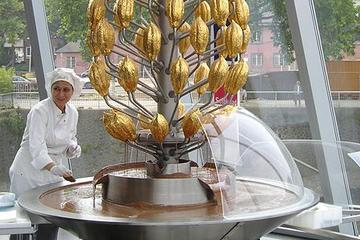
Hans Imhoff, a chocolatier and businessman from Cologne, opened the Schokoladenmuseum in 1993, after retiring from the confectionary business in 1992. The museum that bears the late industrialist's name is a paen to the product of the cacao bean, from its development and primitive processing in the New World by the Olmecs, Mayans and Aztecs, to modern production methods and innovations. The program discusses the role of chocolate in later South American societies and among European elite.
The museum sits inside a glass-and-steel structure shaped like a ship. Inside, the tour takes visitors through the process of chocolate production from the farm to the candy store, continuing through a greenhouse where two species of cacao trees are grown and then on through the industrialization of chocolate production, including vintage advertising campaigns. Miniature machinery allow guests a closer look at the production process, and the chocolate produced by these machines can be sampled. A 3 meter high (9.8 foot) chocolate fountain is the highlight, succeeded only by dipping a wafer into the chocolate stream.
In addition to celebrating the history and taste of chocolate, the museum also strives to educate guests on Fair-Trade chocolate and the international chocolate authorities' commitment to bettering working conditions on cacao farms.
The museum is situated in the Rheinauhafen Peninsula, an urban regeneration project along the Rhine River designed to provide a sort of "urban village," with space for upscale living, cultural enterprises and businesses.